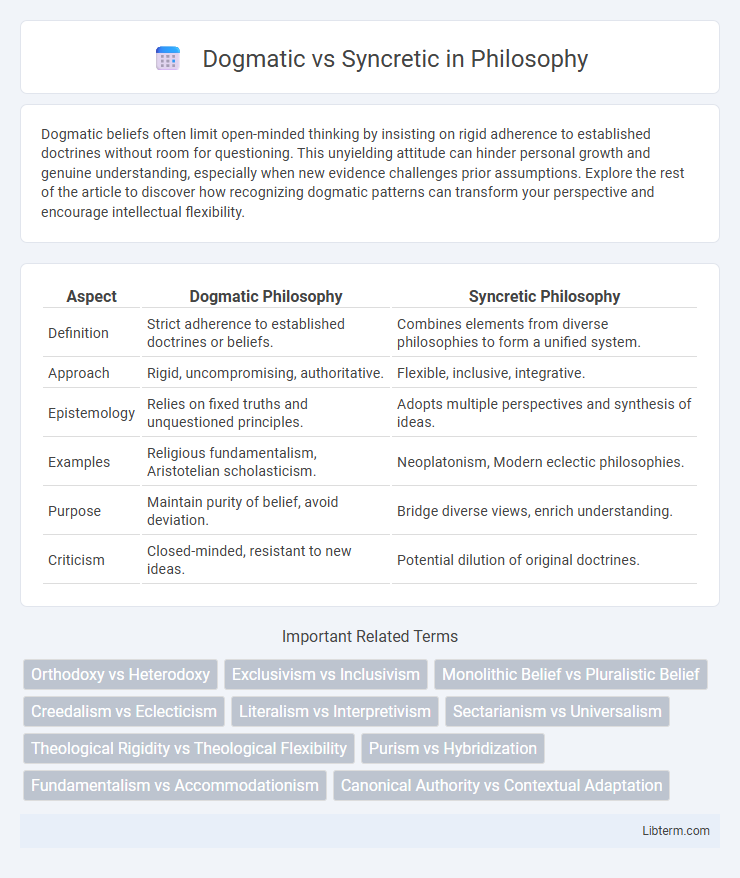Dogmatic beliefs often limit open-minded thinking by insisting on rigid adherence to established doctrines without room for questioning. This unyielding attitude can hinder personal growth and genuine understanding, especially when new evidence challenges prior assumptions. Explore the rest of the article to discover how recognizing dogmatic patterns can transform your perspective and encourage intellectual flexibility.
Table of Comparison
| Aspect | Dogmatic Philosophy | Syncretic Philosophy |
|---|---|---|
| Definition | Strict adherence to established doctrines or beliefs. | Combines elements from diverse philosophies to form a unified system. |
| Approach | Rigid, uncompromising, authoritative. | Flexible, inclusive, integrative. |
| Epistemology | Relies on fixed truths and unquestioned principles. | Adopts multiple perspectives and synthesis of ideas. |
| Examples | Religious fundamentalism, Aristotelian scholasticism. | Neoplatonism, Modern eclectic philosophies. |
| Purpose | Maintain purity of belief, avoid deviation. | Bridge diverse views, enrich understanding. |
| Criticism | Closed-minded, resistant to new ideas. | Potential dilution of original doctrines. |
Understanding Dogmatic and Syncretic Approaches
Dogmatic approaches emphasize strict adherence to established principles and doctrines, often rejecting alternative viewpoints to maintain ideological purity. Syncretic approaches blend elements from different beliefs or systems, promoting flexibility and inclusivity in understanding complex ideas. Understanding the difference between dogmatic rigidity and syncretic openness is crucial for analyzing how individuals or cultures handle conflicting information or traditions.
Historical Origins of Dogmatism and Syncretism
Dogmatism traces its historical origins to ancient philosophical and religious traditions that emphasize unwavering adherence to established doctrines, often linked to early Christian councils and rigid scholasticism in the Middle Ages. Syncretism emerged from cultural and religious interactions in ancient civilizations such as Hellenistic societies, where blending Greek, Egyptian, and Eastern beliefs resulted in hybrid spiritual systems. The evolution of syncretism reflects ongoing efforts to harmonize disparate worldviews, contrasting with dogmatism's commitment to fixed, authoritative truths.
Core Principles of Dogmatic Belief Systems
Dogmatic belief systems are characterized by rigid adherence to established doctrines and core principles that are considered absolute and unchanging, often enforced by authoritative institutions. These core principles emphasize exclusivity, fixed interpretations, and a clear distinction between orthodoxy and heresy, limiting flexibility and reinterpretation. Such systems prioritize doctrinal purity and demand unwavering acceptance from followers, contrasting with syncretic belief systems that blend diverse traditions and adapt principles fluidly.
Key Features of Syncretic Worldviews
Syncretic worldviews blend elements from multiple religious or philosophical systems, fostering inclusivity and flexibility in belief structures. They emphasize adaptation and integration, allowing followers to incorporate diverse rituals, deities, and ethical principles without strict adherence to a single dogma. This pluralistic approach contrasts with dogmatic worldviews, which uphold rigid, authoritative doctrines and discourage doctrinal blending or reinterpretation.
Comparing Rigidity vs Flexibility in Thought
Dogmatic thinking is characterized by rigid adherence to established beliefs and principles, often rejecting alternative viewpoints regardless of evidence. In contrast, syncretic thought embraces flexibility by integrating diverse ideas and adapting to new information while seeking coherence among conflicting perspectives. This contrast highlights dogmatism's resistance to change versus syncretism's openness to cognitive evolution and synthesis.
Influence on Religious and Philosophical Traditions
Dogmatic traditions maintain strict adherence to established doctrines, shaping religious and philosophical systems by reinforcing consistent beliefs and practices across generations. Syncretic approaches blend elements from diverse spiritual and philosophical sources, fostering innovation and adaptability within faiths and ideologies. The influence of dogmatic rigidity versus syncretic flexibility often determines the evolution, inclusivity, and cultural integration of religious and philosophical traditions.
Impact on Social and Cultural Development
Dogmatic belief systems often create rigid social structures and cultural norms that limit diversity and innovation by enforcing strict adherence to established doctrines. Syncretic approaches promote cultural exchange and integration, fostering social cohesion and encouraging adaptability through the blending of different traditions and ideas. The impact on social and cultural development is profound, as dogmatism can hinder progress while syncretism drives cultural evolution and inclusivity.
Modern Examples of Dogmatic and Syncretic Practices
Modern dogmatic practices are evident in rigid ideological movements such as certain fundamentalist religious groups that strictly adhere to unchanging doctrines and reject alternative viewpoints. Syncretic practices emerge prominently in multicultural societies where religious beliefs blend, such as the fusion of indigenous spirituality with Christianity in Latin America or the melding of Buddhism and local traditions in Southeast Asia. These syncretic systems promote cultural integration and adaptability, contrasting sharply with the exclusivity and uniformity characteristic of dogmatic approaches.
Benefits and Drawbacks of Each Approach
Dogmatic approaches prioritize strict adherence to established principles, ensuring consistency and clarity but often limiting flexibility and innovation. Syncretic methods blend diverse ideas and practices, fostering creativity and adaptability, though they may lead to ambiguity and conflicting interpretations. Balancing these approaches can optimize organizational effectiveness by combining stability with openness to new perspectives.
Navigating Dogmatism and Syncretism in Today’s World
Navigating dogmatism and syncretism in today's world requires understanding the rigid adherence to established doctrines versus the blending of diverse beliefs. Embracing syncretism fosters cultural exchange and innovation by integrating multiple perspectives, while recognizing dogmatism's role helps identify when inflexible thinking hinders progress. Balancing these approaches enables individuals and societies to adapt thoughtfully without forsaking core values or openness to new ideas.
Dogmatic Infographic

 libterm.com
libterm.com